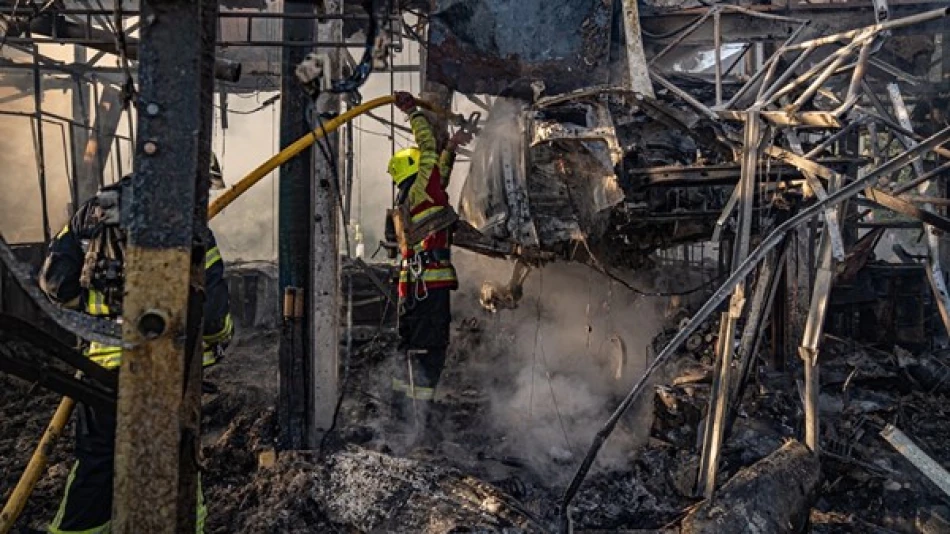
Russia Strikes Ukrainian Gas Distribution Facility: Escalating Conflict Disrupts Energy Supply
Russia Escalates Winter Campaign with Massive Drone Assault on Ukraine's Energy Infrastructure
Russia launched one of its largest coordinated drone attacks in recent months, deploying over 100 drones and 150 glide bombs against Ukrainian cities and critical infrastructure. The strikes, which targeted a gas distribution facility in northeastern Sumy region and multiple urban centers, signal Moscow's renewed emphasis on crippling Ukraine's energy grid as winter approaches—a strategy that has become central to Russia's military doctrine since conventional ground advances stalled.
Strategic Targeting of Energy Assets
The Russian Defense Ministry confirmed Tuesday that its drones struck a gas distribution station in Sumy region, describing the facility as a "gas extraction, storage, and distribution point" used by Ukrainian combat and logistics units. This characterization reflects Russia's consistent narrative of framing civilian infrastructure as legitimate military targets.
The choice to target gas infrastructure is particularly significant as Ukraine enters its third winter under Russian assault. Energy warfare has proven one of Moscow's most effective tools for maintaining pressure on Ukrainian civilians and military operations simultaneously, following the playbook established during the 2022-2023 winter campaign that left millions without power and heat.
Scale and Geographic Spread
Ukrainian President Volodymyr Zelensky reported that the overnight assault affected cities across central, southern, and eastern Ukraine, representing a broad geographic spread that suggests coordinated planning rather than opportunistic strikes. The deployment of over 100 drones alongside 150 glide bombs indicates Russia's ability to sustain large-scale operations despite nearly two years of international sanctions targeting its defense industrial base.
The attack resulted in at least one death in southern Mykolaiv region and two injuries in northeastern Kharkiv city, according to Ukrainian officials. While casualty numbers remained relatively low, the psychological and economic impact of such widespread strikes extends far beyond immediate physical damage.
Military and Economic Implications
From a strategic perspective, this escalation serves multiple Russian objectives. First, it demonstrates Moscow's retained capacity for complex, multi-vector operations despite equipment losses and production constraints. Second, it maintains pressure on Ukrainian air defense systems, forcing Kyiv to expend costly interceptor missiles and potentially creating gaps in coverage.
The timing also coincides with Ukraine's ongoing efforts to secure additional Western air defense systems and long-range strike capabilities. By intensifying attacks on energy infrastructure, Russia may be attempting to shift the narrative away from Ukrainian territorial gains and toward civilian suffering, potentially influencing Western public opinion and military aid decisions.
Historical Context and Future Trajectory
This assault pattern mirrors Russia's systematic targeting of Ukrainian power infrastructure that began in October 2022, following the Crimean Bridge bombing. That campaign ultimately failed to break Ukrainian resistance but succeeded in causing widespread civilian hardship and economic damage estimated in billions of dollars.
The renewed intensity suggests Russia may be preparing for a sustained winter campaign aimed at degrading Ukraine's ability to maintain both military operations and civilian morale. However, Ukraine's energy sector has demonstrated remarkable resilience and adaptation, with rapid repair capabilities and distributed generation helping maintain grid stability even under intense bombardment.
The strategic question remains whether Russia can achieve through infrastructure attacks what it has failed to accomplish through conventional military operations—forcing Ukraine toward negotiation from a position of weakness. Current evidence suggests Ukrainian society's capacity to endure such campaigns while maintaining resistance has only strengthened over nearly two years of conflict.
 Layla Al Mansoori
Layla Al Mansoori







